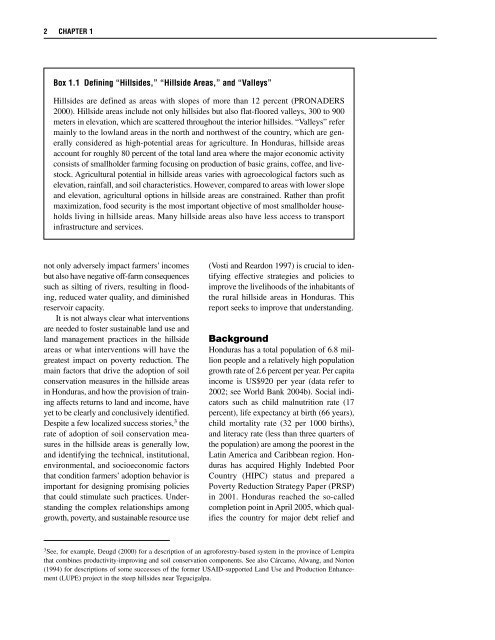Rural Development Policies and Sustainable Land Use in the ...
Rural Development Policies and Sustainable Land Use in the ...
Rural Development Policies and Sustainable Land Use in the ...
Create successful ePaper yourself
Turn your PDF publications into a flip-book with our unique Google optimized e-Paper software.
2 CHAPTER 1<br />
Box 1.1 Def<strong>in</strong><strong>in</strong>g “Hillsides,” “Hillside Areas,” <strong>and</strong> “Valleys”<br />
Hillsides are def<strong>in</strong>ed as areas with slopes of more than 12 percent (PRONADERS<br />
2000). Hillside areas <strong>in</strong>clude not only hillsides but also flat-floored valleys, 300 to 900<br />
meters <strong>in</strong> elevation, which are scattered throughout <strong>the</strong> <strong>in</strong>terior hillsides. “Valleys” refer<br />
ma<strong>in</strong>ly to <strong>the</strong> lowl<strong>and</strong> areas <strong>in</strong> <strong>the</strong> north <strong>and</strong> northwest of <strong>the</strong> country, which are generally<br />
considered as high-potential areas for agriculture. In Honduras, hillside areas<br />
account for roughly 80 percent of <strong>the</strong> total l<strong>and</strong> area where <strong>the</strong> major economic activity<br />
consists of smallholder farm<strong>in</strong>g focus<strong>in</strong>g on production of basic gra<strong>in</strong>s, coffee, <strong>and</strong> livestock.<br />
Agricultural potential <strong>in</strong> hillside areas varies with agroecological factors such as<br />
elevation, ra<strong>in</strong>fall, <strong>and</strong> soil characteristics. However, compared to areas with lower slope<br />
<strong>and</strong> elevation, agricultural options <strong>in</strong> hillside areas are constra<strong>in</strong>ed. Ra<strong>the</strong>r than profit<br />
maximization, food security is <strong>the</strong> most important objective of most smallholder households<br />
liv<strong>in</strong>g <strong>in</strong> hillside areas. Many hillside areas also have less access to transport<br />
<strong>in</strong>frastructure <strong>and</strong> services.<br />
not only adversely impact farmers’ <strong>in</strong>comes<br />
but also have negative off-farm consequences<br />
such as silt<strong>in</strong>g of rivers, result<strong>in</strong>g <strong>in</strong> flood<strong>in</strong>g,<br />
reduced water quality, <strong>and</strong> dim<strong>in</strong>ished<br />
reservoir capacity.<br />
It is not always clear what <strong>in</strong>terventions<br />
are needed to foster susta<strong>in</strong>able l<strong>and</strong> use <strong>and</strong><br />
l<strong>and</strong> management practices <strong>in</strong> <strong>the</strong> hillside<br />
areas or what <strong>in</strong>terventions will have <strong>the</strong><br />
greatest impact on poverty reduction. The<br />
ma<strong>in</strong> factors that drive <strong>the</strong> adoption of soil<br />
conservation measures <strong>in</strong> <strong>the</strong> hillside areas<br />
<strong>in</strong> Honduras, <strong>and</strong> how <strong>the</strong> provision of tra<strong>in</strong><strong>in</strong>g<br />
affects returns to l<strong>and</strong> <strong>and</strong> <strong>in</strong>come, have<br />
yet to be clearly <strong>and</strong> conclusively identified.<br />
Despite a few localized success stories, 3 <strong>the</strong><br />
rate of adoption of soil conservation measures<br />
<strong>in</strong> <strong>the</strong> hillside areas is generally low,<br />
<strong>and</strong> identify<strong>in</strong>g <strong>the</strong> technical, <strong>in</strong>stitutional,<br />
environmental, <strong>and</strong> socioeconomic factors<br />
that condition farmers’ adoption behavior is<br />
important for design<strong>in</strong>g promis<strong>in</strong>g policies<br />
that could stimulate such practices. Underst<strong>and</strong><strong>in</strong>g<br />
<strong>the</strong> complex relationships among<br />
growth, poverty, <strong>and</strong> susta<strong>in</strong>able resource use<br />
(Vosti <strong>and</strong> Reardon 1997) is crucial to identify<strong>in</strong>g<br />
effective strategies <strong>and</strong> policies to<br />
improve <strong>the</strong> livelihoods of <strong>the</strong> <strong>in</strong>habitants of<br />
<strong>the</strong> rural hillside areas <strong>in</strong> Honduras. This<br />
report seeks to improve that underst<strong>and</strong><strong>in</strong>g.<br />
Background<br />
Honduras has a total population of 6.8 million<br />
people <strong>and</strong> a relatively high population<br />
growth rate of 2.6 percent per year. Per capita<br />
<strong>in</strong>come is US$920 per year (data refer to<br />
2002; see World Bank 2004b). Social <strong>in</strong>dicators<br />
such as child malnutrition rate (17<br />
percent), life expectancy at birth (66 years),<br />
child mortality rate (32 per 1000 births),<br />
<strong>and</strong> literacy rate (less than three quarters of<br />
<strong>the</strong> population) are among <strong>the</strong> poorest <strong>in</strong> <strong>the</strong><br />
Lat<strong>in</strong> America <strong>and</strong> Caribbean region. Honduras<br />
has acquired Highly Indebted Poor<br />
Country (HIPC) status <strong>and</strong> prepared a<br />
Poverty Reduction Strategy Paper (PRSP)<br />
<strong>in</strong> 2001. Honduras reached <strong>the</strong> so-called<br />
completion po<strong>in</strong>t <strong>in</strong> April 2005, which qualifies<br />
<strong>the</strong> country for major debt relief <strong>and</strong><br />
3<br />
See, for example, Deugd (2000) for a description of an agroforestry-based system <strong>in</strong> <strong>the</strong> prov<strong>in</strong>ce of Lempira<br />
that comb<strong>in</strong>es productivity-improv<strong>in</strong>g <strong>and</strong> soil conservation components. See also Cárcamo, Alwang, <strong>and</strong> Norton<br />
(1994) for descriptions of some successes of <strong>the</strong> former USAID-supported L<strong>and</strong> <strong>Use</strong> <strong>and</strong> Production Enhancement<br />
(LUPE) project <strong>in</strong> <strong>the</strong> steep hillsides near Tegucigalpa.
















